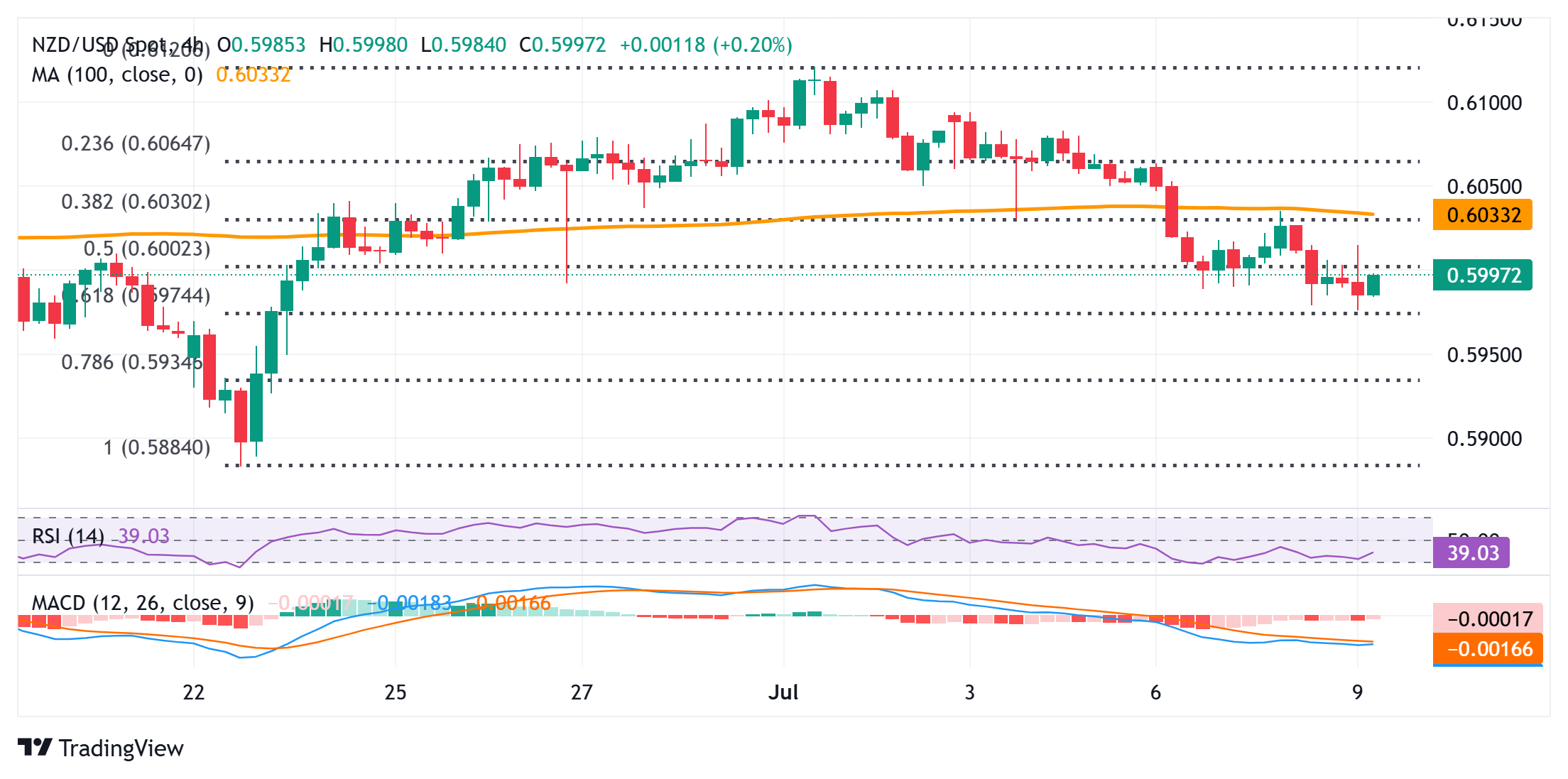
- NZD/USD struggles to capitalize on the post-RBNZ spike during the Asian session.
- Reduced Fed rate cut bets and trade jitters benefit the USD and weigh on the Kiwi.
- The technical setup favors bearish traders and backs the case for additional losses.
The NZD/USD pair fades an intraday spike to the 0.6015 area that followed the Reserve Bank of New Zealand’s (RBNZ) widely expected decision to hold rates steady and retests a two-week low during the Asian session on Wednesday. Spot prices currently trade below the 0.6000 psychological mark and seem vulnerable to slide further amid a broadly stronger US Dollar (USD).
The USD Index (DXY), which tracks the Greenback against a basket of currencies, remains well supported by expectations that higher US tariffs would underpin inflation and allow the Federal Reserve (Fed) to stick to its wait-and-see approach. Adding to this, concerns about the economic fallout from US President Donald Trump’s trade policies weigh on investors’ sentiment. This further benefits the safe-haven buck and acts as a headwind for the risk-sensitive Kiwi.
From a technical perspective, the NZD/USD pair’s overnight breakdown below the 100-period Simple Moving Average (SMA) on the 4-hour chart was seen as a key trigger for bearish traders. Moreover, negative oscillators on hourly/daily charts suggest that the path of least resistance for spot prices is to the downside and back the case for an extension of the recent corrective slide from the 0.6120 area, or the highest level since October 2024 touched earlier this month.
However, it will still be prudent to wait for some follow-through selling below the 61.8% Fibonacci retracement level of the June-July rally, around the 0.5970 area, before positioning for deeper losses. The NZD/USD pair might then accelerate the fall to the 0.5935 intermediate support before eventually dropping to the 0.5900 round figure and June monthly swing low, around the 0.5880 region.
On the flip side, attempted recovery might now confront some resistance near the 0.6025 area (50% retracement level), above which the NZD/USD pair could climb to the 0.6060 region, or the 38.2% Fibo. retracement level. The subsequent move up could allow spot prices to reclaim the 0.6100 mark and retest the year-to-date peak, around the 0.6120 zone. A sustained move beyond the latter would be seen as a fresh trigger for bulls and pave the way for additional gains.
NZD/USD 4-hour chart

New Zealand Dollar FAQs
The New Zealand Dollar (NZD), also known as the Kiwi, is a well-known traded currency among investors. Its value is broadly determined by the health of the New Zealand economy and the country’s central bank policy. Still, there are some unique particularities that also can make NZD move. The performance of the Chinese economy tends to move the Kiwi because China is New Zealand’s biggest trading partner. Bad news for the Chinese economy likely means less New Zealand exports to the country, hitting the economy and thus its currency. Another factor moving NZD is dairy prices as the dairy industry is New Zealand’s main export. High dairy prices boost export income, contributing positively to the economy and thus to the NZD.
The Reserve Bank of New Zealand (RBNZ) aims to achieve and maintain an inflation rate between 1% and 3% over the medium term, with a focus to keep it near the 2% mid-point. To this end, the bank sets an appropriate level of interest rates. When inflation is too high, the RBNZ will increase interest rates to cool the economy, but the move will also make bond yields higher, increasing investors’ appeal to invest in the country and thus boosting NZD. On the contrary, lower interest rates tend to weaken NZD. The so-called rate differential, or how rates in New Zealand are or are expected to be compared to the ones set by the US Federal Reserve, can also play a key role in moving the NZD/USD pair.
Macroeconomic data releases in New Zealand are key to assess the state of the economy and can impact the New Zealand Dollar’s (NZD) valuation. A strong economy, based on high economic growth, low unemployment and high confidence is good for NZD. High economic growth attracts foreign investment and may encourage the Reserve Bank of New Zealand to increase interest rates, if this economic strength comes together with elevated inflation. Conversely, if economic data is weak, NZD is likely to depreciate.
The New Zealand Dollar (NZD) tends to strengthen during risk-on periods, or when investors perceive that broader market risks are low and are optimistic about growth. This tends to lead to a more favorable outlook for commodities and so-called ‘commodity currencies’ such as the Kiwi. Conversely, NZD tends to weaken at times of market turbulence or economic uncertainty as investors tend to sell higher-risk assets and flee to the more-stable safe havens.
Information on these pages contains forward-looking statements that involve risks and uncertainties. Markets and instruments profiled on this page are for informational purposes only and should not in any way come across as a recommendation to buy or sell in these assets. You should do your own thorough research before making any investment decisions. FXStreet does not in any way guarantee that this information is free from mistakes, errors, or material misstatements. It also does not guarantee that this information is of a timely nature. Investing in Open Markets involves a great deal of risk, including the loss of all or a portion of your investment, as well as emotional distress. All risks, losses and costs associated with investing, including total loss of principal, are your responsibility. The views and opinions expressed in this article are those of the authors and do not necessarily reflect the official policy or position of FXStreet nor its advertisers. The author will not be held responsible for information that is found at the end of links posted on this page.
If not otherwise explicitly mentioned in the body of the article, at the time of writing, the author has no position in any stock mentioned in this article and no business relationship with any company mentioned. The author has not received compensation for writing this article, other than from FXStreet.
FXStreet and the author do not provide personalized recommendations. The author makes no representations as to the accuracy, completeness, or suitability of this information. FXStreet and the author will not be liable for any errors, omissions or any losses, injuries or damages arising from this information and its display or use. Errors and omissions excepted.
The author and FXStreet are not registered investment advisors and nothing in this article is intended to be investment advice.







